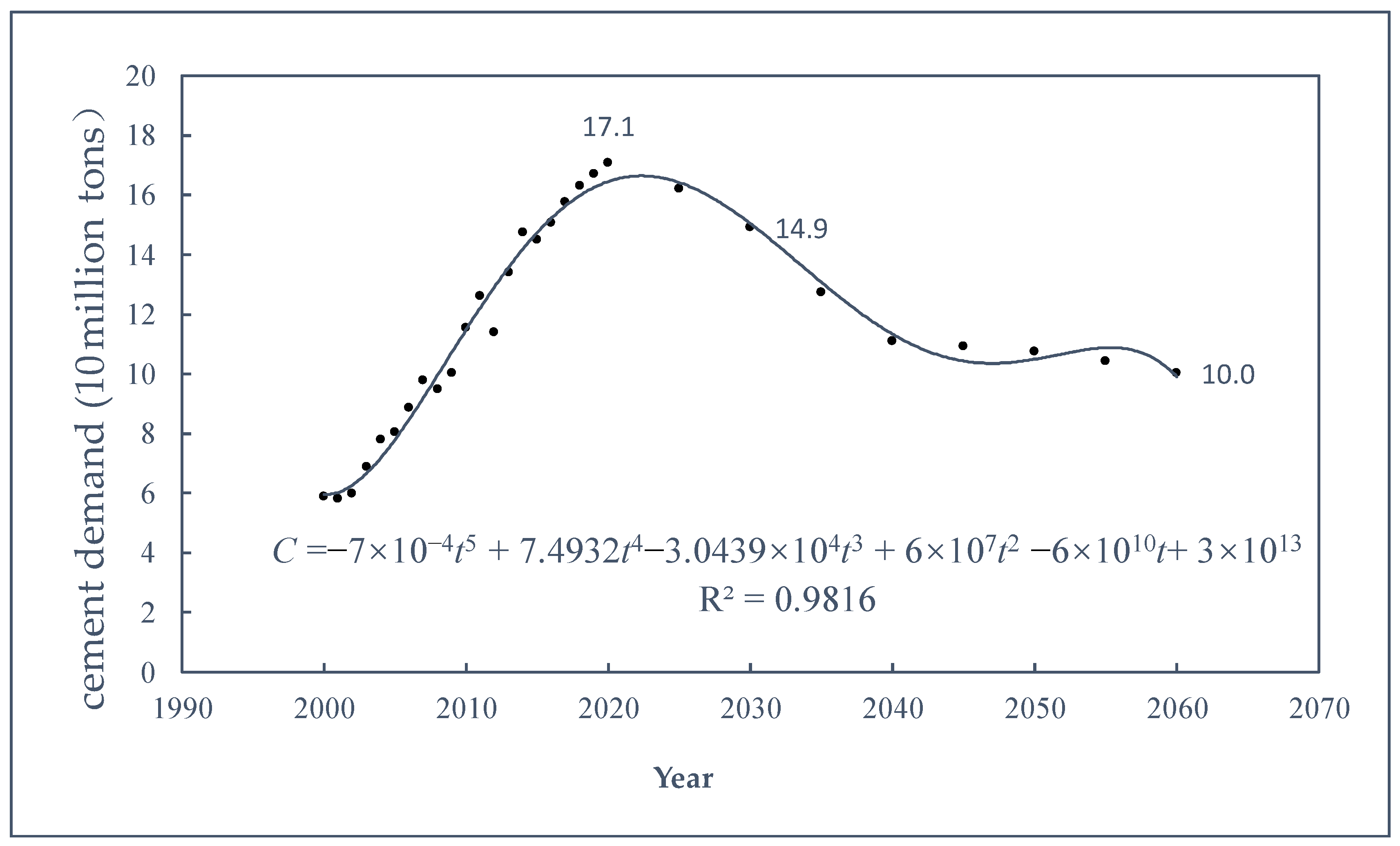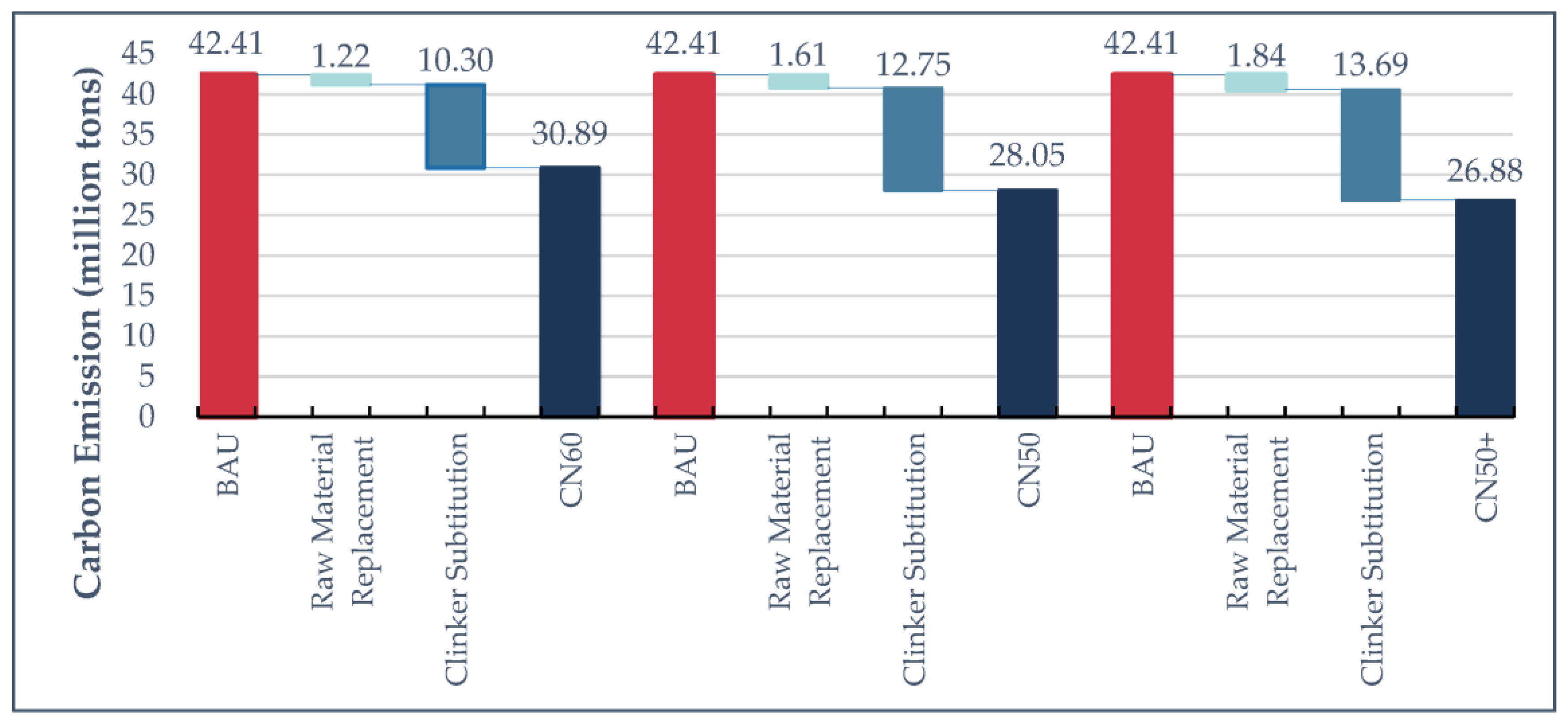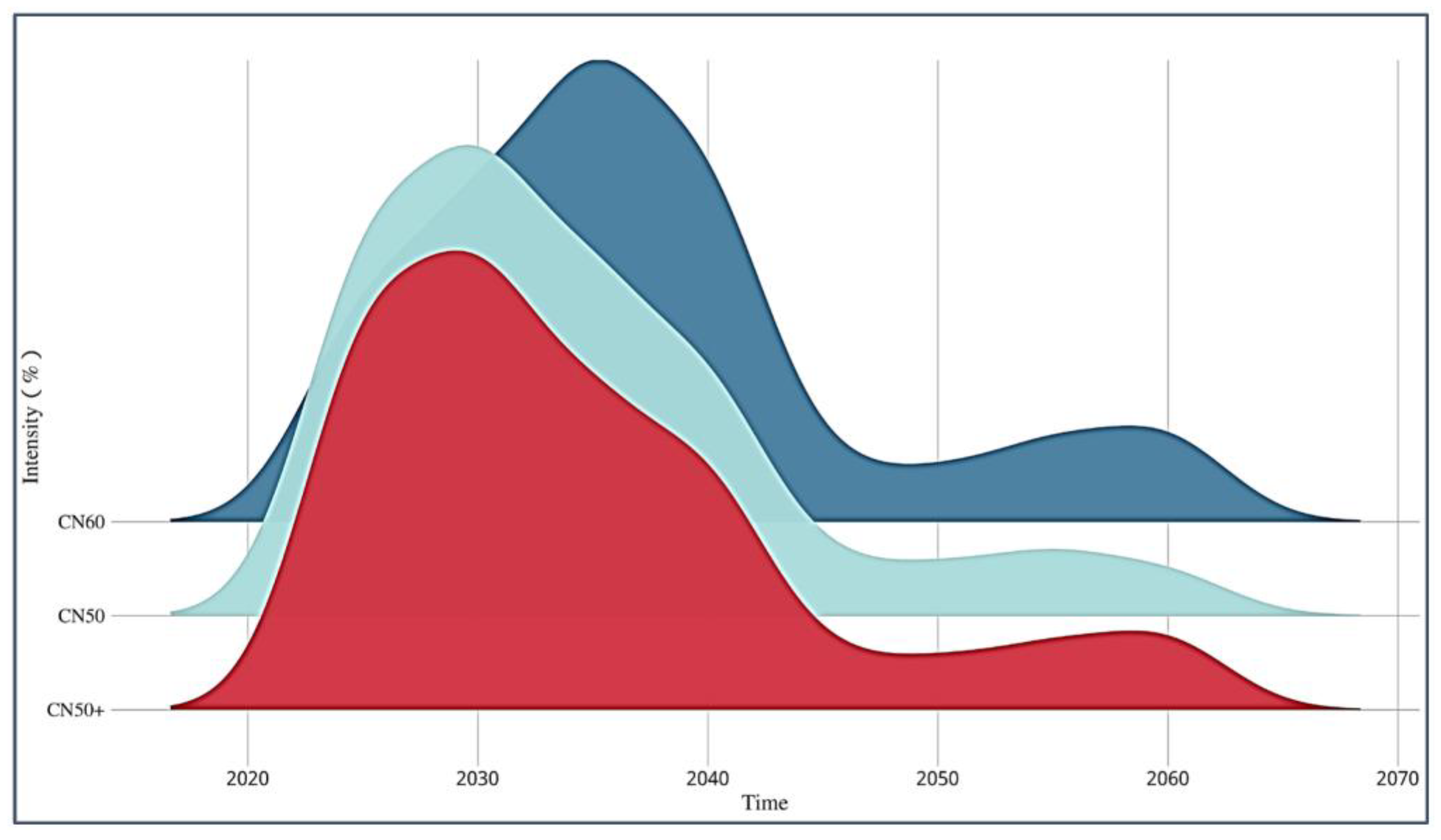A Scenario Simulation of Material Substitution in the Cement Industry under the Carbon Neutral Strategy: A Case Study of Guangdong
Abstract
1. Introduction
2. Methods and Key Parameters
2.1. Methodology of Carbon Emission Calculation
2.2. Forecast of Future Cement Demand in Guangdong
2.3. Forecast of the Future Application of Raw Material Replacement and Clinker Substitution in Guangdong
2.3.1. Analysis of Prospects for Raw Material Substitution
2.3.2. Analysis of Application Prospect of Clinker Substitution
2.4. Scenario Setting
2.5. Main Parameters
2.5.1. Activity Level
2.5.2. Emission Factor
2.6. Summary of Scenario Parameter Settings
3. Results and Analysis
3.1. Carbon Dioxide Emissions and Cumulative Emissions from Cement Process
3.2. Emission Reduction Potential of Raw Material Replacement and Clinker Substitution
4. Conclusions
- This study analyzed the future demand for cement products in Guangdong and found that demand peaks around 2020 and declines to 100 million tons by 2060;
- In the pre-carbon neutrality period, with the strong promotion of alternative technologies and the sharp reduction in cement demand, material substitution measures make an outstanding contribution to emission reduction;
- There are two factors driving substitution technology in the cement industry—the decline of the CCR and the recycling of low carbon materials. By comparison, the driving effect of the former is greater;
- The timing to set the carbon neutrality target affects the upper limit of cumulative carbon emissions and the distribution of abatement pressure scales over time. Setting targets in advance is conducive to prioritizing the deployment of policy resources, ramping up the emission reduction efforts in the early stage, and alleviating the pressure of emission reduction in the middle and late stages.
5. Policy Implications
Author Contributions
Funding
Institutional Review Board Statement
Informed Consent Statement
Data Availability Statement
Acknowledgments
Conflicts of Interest
Abbreviations
| BAU | Business as usual (a scenario in this study) |
| CCR | Clinker-to-Cement Ratio |
| CNY | Chinese yuan |
| CN60 | “Carbon neutrality 60” scenario |
| CN50 | “Carbon neutrality 50” scenario |
| CN50+ | “Carbon neutrality 50 intensification” scenario |
| CO2 | Carbon dioxide |
| GDP | Gross Domestic Product |
| IEA | International Energy Agency |
| IPCC | Intergovernmental Panel on Climate Change |
| RMR | Raw Material Replacement (a scenario in this study) |
| UR | Urbanization rate |
References
- Amran, M.; Makul, N.; Fediuk, R.; Lee, Y.H.; Vatin, N.I.; Lee, Y.Y.; Mohammed, K. Global Carbon Recoverability Experiences from the Cement Industry. Case Stud. Constr. Mater. 2022, 17, e01439. [Google Scholar] [CrossRef]
- Oh, D.-Y.; Noguchi, T.; Kitagaki, R.; Park, W.-J. CO2 Emission Reduction by Reuse of Building Material Waste in the Japanese Cement Industry. Renew. Sustain. Energy Rev. 2014, 38, 796–810. [Google Scholar] [CrossRef]
- Miller, S.A.; Habert, G.; Myers, R.J.; Harvey, J.T. Achieving Net Zero Greenhouse Gas Emissions in the Cement Industry via Value Chain Mitigation Strategies. One Earth 2021, 4, 1398–1411. [Google Scholar] [CrossRef]
- Lehne, J.; Preston, F. Making Concrete Change: Innovation in Low-Carbon Cement and Concrete; Chatham House: London, UK, 2018. [Google Scholar]
- Zhou, A.; Zhang, W.; Wei, H.; Liu, T.; Zou, D.; Guo, H. A Novel Approach for Recycling Engineering Sediment Waste as Sustainable Supplementary Cementitious Materials. Resour. Conserv. Recycl. 2021, 167, 105435. [Google Scholar] [CrossRef]
- Mechtcherine, V. Novel Cement-Based Composites for the Strengthening and Repair of Concrete Structures. Constr. Build. Mater. 2013, 41, 365–373. [Google Scholar] [CrossRef]
- Worrell, E.; Martin, N.; Price, L. Potentials for Energy Efficiency Improvement in the US Cement Industry. Energy 2000, 25, 1189–1214. [Google Scholar] [CrossRef]
- Morrow, W.R.; Hasanbeigi, A.; Sathaye, J.; Xu, T. Assessment of Energy Efficiency Improvement and CO2 Emission Reduction Potentials in India’s Cement and Iron & Steel Industries. J. Clean. Prod. 2014, 65, 131–141. [Google Scholar] [CrossRef]
- Hills, T.; Leeson, D.; Florin, N.; Fennell, P. Carbon Capture in the Cement Industry: Technologies, Progress, and Retrofitting. Environ. Sci. Technol. 2016, 50, 368–377. [Google Scholar] [CrossRef]
- Guo, S.; Li, Y.; Wang, Y.; Wang, L.; Sun, Y.; Liu, L. Recent Advances in Biochar-Based Adsorbents for CO2 Capture. Carbon Capture Sci. Technol. 2022, 4, 100059. [Google Scholar] [CrossRef]
- Cement—Analysis—IEA. Available online: https://www.iea.org/reports/cement (accessed on 25 February 2023).
- Black, L. 17—Low Clinker Cement as a Sustainable Construction Material. In Sustainability of Construction Materials, 2nd ed.; Khatib, J.M., Ed.; Woodhead Publishing Series in Civil and Structural Engineering; Woodhead Publishing: Sawston, UK, 2016; pp. 415–457. ISBN 978-0-08-100995-6. [Google Scholar]
- Kajaste, R.; Hurme, M. Cement Industry Greenhouse Gas Emissions—Management Options and Abatement Cost. J. Clean. Prod. 2016, 112, 4041–4052. [Google Scholar] [CrossRef]
- Abdul-Wahab, S.A.; Al-Dhamri, H.; Ram, G.; Chatterjee, V.P. An Overview of Alternative Raw Materials Used in Cement and Clinker Manufacturing. Int. J. Sustain. Eng. 2021, 14, 743–760. [Google Scholar] [CrossRef]
- Avet, F.H. Investigation of the Grade of Calcined Clays Used as Clinker Substitute in Limestone Calcined Clay Cement (LC3); EPFL: Lausanne, Switzerland, 2017; Available online: https://infoscience.epfl.ch/record/232412 (accessed on 13 November 2022).
- Barcelo, L.; Kline, J.; Walenta, G.; Gartner, E. Cement and Carbon Emissions. Mater. Struct. 2014, 47, 1055–1065. [Google Scholar] [CrossRef]
- Gartner, E.; Sui, T. Alternative Cement Clinkers. Cem. Concr. Res. 2018, 114, 27–39. [Google Scholar] [CrossRef]
- Malacarne, C.S.; Longhi, M.A.; Silva, M.R.C.; Gonçalves, J.P.; Rodríguez, E.D.; Kirchheim, A.P. Influence of Low-Grade Materials as Clinker Substitute on the Rheological Behavior, Hydration and Mechanical Performance of Ternary Cements. Case Stud. Constr. Mater. 2021, 15, e00776. [Google Scholar] [CrossRef]
- Schneider, M.; Romer, M.; Tschudin, M.; Bolio, H. Sustainable Cement Production—Present and Future. Cem. Concr. Res. 2011, 41, 642–650. [Google Scholar] [CrossRef]
- Hafez, H.; Teirelbar, A.; Tošić, N.; Ikumi, T.; de la Fuente, A. Data-Driven Optimization Tool for the Functional, Economic, and Environmental Properties of Blended Cement Concrete Using Supplementary Cementitious Materials. J. Build. Eng. 2023, 67, 106022. [Google Scholar] [CrossRef]
- Castillo, D.; Cruz, J.C.; Trejo-Arroyo, D.L.; Muzquiz, E.M.; Zarhri, Z.; Gurrola, M.P.; Vega-Azamar, R.E. Characterization of Poultry Litter Ashes as a Supplementary Cementitious Material. Case Stud. Constr. Mater. 2022, 17, e01278. [Google Scholar] [CrossRef]
- Gartner, E.; Hirao, H. A Review of Alternative Approaches to the Reduction of CO2 Emissions Associated with the Manufacture of the Binder Phase in Concrete. Cem. Concr. Res. 2015, 78, 126–142. [Google Scholar] [CrossRef]
- Bordy, A.; Younsi, A.; Aggoun, S.; Fiorio, B. Cement Substitution by a Recycled Cement Paste Fine: Role of the Residual Anhydrous Clinker. Constr. Build. Mater. 2017, 132, 1–8. [Google Scholar] [CrossRef]
- Cosoli, G.; Mobili, A.; Giulietti, N.; Chiariotti, P.; Pandarese, G.; Tittarelli, F.; Bellezze, T.; Mikanovic, N.; Revel, G.M. Performance of Concretes Manufactured with Newly Developed Low-Clinker Cements Exposed to Water and Chlorides: Characterization by Means of Electrical Impedance Measurements. Constr. Build. Mater. 2021, 271, 121546. [Google Scholar] [CrossRef]
- Frías, M.; Vigil de la Villa, R.; García, R.; Martínez, S.; Villar, E.; Vegas, I. Effect of a High Content in Activated Carbon Waste on Low Clinker Cement Microstructure and Properties. Constr. Build. Mater. 2018, 184, 11–19. [Google Scholar] [CrossRef]
- Jiang, W.; Li, X.; Lv, Y.; Jiang, D.; Liu, Z.; He, C. Mechanical and Hydration Properties of Low Clinker Cement Containing High Volume Superfine Blast Furnace Slag and Nano Silica. Constr. Build. Mater. 2020, 238, 117683. [Google Scholar] [CrossRef]
- Lämmlein, T.D.; Messina, F.; Wyrzykowski, M.; Terrasi, G.P.; Lura, P. Low Clinker High Performance Concretes and Their Potential in CFRP-Prestressed Structural Elements. Cem. Concr. Compos. 2019, 100, 130–138. [Google Scholar] [CrossRef]
- Staněk, T.; Sulovský, P.; Boháč, M. Berlinite Substitution in the Cement Clinker. Cem. Concr. Res. 2017, 92, 21–28. [Google Scholar] [CrossRef]
- Uchikawa, H.; Hanehara, S. 8—Recycling of Waste as an Alternative Raw Material and Fuel in Cement Manufacturing. In Waste Materials Used in Concrete Manufacturing; Chandra, S., Ed.; William Andrew Publishing: Westwood, NJ, USA, 1996; pp. 430–553. ISBN 978-0-8155-1393-3. [Google Scholar]
- Navia, R.; Rivela, B.; Lorber, K.E.; Méndez, R. Recycling Contaminated Soil as Alternative Raw Material in Cement Facilities: Life Cycle Assessment. Resour. Conserv. Recycl. 2006, 48, 339–356. [Google Scholar] [CrossRef]
- Tsakiridis, P.E.; Oustadakis, P.; Agatzini-Leonardou, S. Black Dross Leached Residue: An Alternative Raw Material for Portland Cement Clinker. Waste Biomass Valorization 2014, 5, 973–983. [Google Scholar] [CrossRef]
- Chen, H.; Ma, X.; Dai, H. Reuse of Water Purification Sludge as Raw Material in Cement Production. Cem. Concr. Compos. 2010, 32, 436–439. [Google Scholar] [CrossRef]
- Diliberto, C.; Lecomte, A.; Mechling, J.-M.; Izoret, L.; Smith, A. Valorisation of Recycled Concrete Sands in Cement Raw Meal for Cement Production. Mater. Struct. 2017, 50, 127. [Google Scholar] [CrossRef]
- He, Z.; Shen, A.; Wu, H.; Wang, W.; Wang, L.; Yao, C.; Wu, J. Research Progress on Recycled Clay Brick Waste as an Alternative to Cement for Sustainable Construction Materials. Constr. Build. Mater. 2021, 274, 122113. [Google Scholar] [CrossRef]
- Puertas, F.; García-Díaz, I.; Palacios, M.; Gazulla, M.F.; Gómez, M.P.; Orduña, M. Clinkers and Cements Obtained from Raw Mix Containing Ceramic Waste as a Raw Material. Characterization, Hydration and Leaching Studies. Cem. Concr. Compos. 2010, 32, 175–186. [Google Scholar] [CrossRef]
- Puertas, F.; García-Díaz, I.; Barba, A.; Gazulla, M.F.; Palacios, M.; Gómez, M.P.; Martínez-Ramírez, S. Ceramic Wastes as Alternative Raw Materials for Portland Cement Clinker Production. Cem. Concr. Compos. 2008, 30, 798–805. [Google Scholar] [CrossRef]
- Punmatharith, T.; Rachakornkij, M.; Imyim, A.; Wecharatana, M. Co-Processing of Grinding Sludge as Alternative Raw Material in Portland Cement Clinker Production. J. Appl. Sci. 2010, 10, 1525–1535. [Google Scholar] [CrossRef]
- Shih, P.-H.; Chang, J.-E.; Lu, H.-C.; Chiang, L.-C. Reuse of Heavy Metal-Containing Sludges in Cement Production. Cem. Concr. Res. 2005, 35, 2110–2115. [Google Scholar] [CrossRef]
- He, J.; Hu, S. Ecological Efficiency and Its Determining Factors in an Urban Agglomeration in China: The Chengdu-Chongqing Urban Agglomeration. Urban Clim. 2022, 41, 101071. [Google Scholar] [CrossRef]
- Damineli, B.L.; John, V.M. Developing Low CO2 Concretes: Is Clinker Replacement Sufficient? The Need of Cement Use Efficiency Improvement. Key Eng. Mater. 2012, 517, 342–351. [Google Scholar] [CrossRef]
- Zhou, S.; Gu, A.; Tong, Q.; Guo, Y.; Wei, X. Multi-scenario Simulation on Reducing CO2 Emissions from China’s Major Manufacturing Industries Targeting 2060. J. Ind. Ecol. 2022, 26, 850–861. [Google Scholar] [CrossRef]
- Sairatanathongkham, W.; Wangjiraniran, W. Potential of Fly Ash Utilization for the Clinker Substitution in Cement Industry in Thailand. Mater. Sci. Forum 2017, 883, 97–101. [Google Scholar] [CrossRef]
- Xu, J.-H.; Fleiter, T.; Fan, Y.; Eichhammer, W. CO2 Emissions Reduction Potential in China’s Cement Industry Compared to IEA’s Cement Technology Roadmap up to 2050. Appl. Energy 2014, 130, 592–602. [Google Scholar] [CrossRef]
- Zhang, J.; Liu, G.; Chen, B.; Song, D.; Qi, J.; Liu, X. Analysis of CO2 Emission for the Cement Manufacturing with Alternative Raw Materials: A LCA-Based Framework. Energy Procedia 2014, 61, 2541–2545. [Google Scholar] [CrossRef]
- Richang, X.; (Guangdong province Cement Association, GDCA, Foshan, China). Personal communication, 2023.
- IPCC. 2019 Refinement to the 2006 IPCC Guidelines for National Greenhouse Gas Inventories. Available online: https://www.ipcc-nggip.iges.or.jp/public/2019rf/index.html (accessed on 18 March 2023).
- Uwasu, M.; Hara, K.; Yabar, H. World Cement Production and Environmental Implications. Environ. Dev. 2014, 10, 36–47. [Google Scholar] [CrossRef]
- Wei, J.; Cen, K.; Geng, Y. China’s Cement Demand and CO2 Emissions toward 2030: From the Perspective of Socioeconomic, Technology and Population. Environ. Sci. Pollut. Res. 2019, 26, 6409–6423. [Google Scholar] [CrossRef] [PubMed]
- Guangdong Statistics Bureau. Available online: http://stats.gd.gov.cn/gdtjnj/index.html (accessed on 2 November 2022).
- International Energy Agency. Technology Roadmap—Low-Carbon Transition in the Cement Industry. Available online: https://www.iea.org/reports/technology-roadmap-low-carbon-transition-in-the-cement-industry (accessed on 25 February 2023).
- Wu, S.; Zhu, L.; Sun, T.; Xu, C.; Li, X.; Wang, X. Comprehensive Utilization Status and Prospect of Red Mud. Met. Mine 2019, 6, 38–44. [Google Scholar] [CrossRef]
- Liu, J.; He, C.; Song, J.; Pang, C.; Li, J.; Wang, Q.; Chen, G.; Chen, P. Study on the Preparation and Performance of Cement Clinker Made of Steel Slag. J. Pingxiang Univ. 2020, 37, 111–116. [Google Scholar]
- Landeta, J. Current Validity of the Delphi Method in Social Sciences. Technol. Forecast. Soc. Chang. 2005, 73, 467–482. [Google Scholar] [CrossRef]





| Scenario | 2020 | 2025 | 2030 | 2035 | 2040 | 2050 | 2060 | |
|---|---|---|---|---|---|---|---|---|
| CCR (clinker-to-cement ratio) | CN60 | 0.8 | 0.73 | 0.65 | 0.64 | 0.63 | 0.62 | 0.6 |
| CN50 | 0.8 | 0.72 | 0.63 | 0.62 | 0.60 | 0.58 | 0.55 | |
| CN50+ | 0.8 | 0.71 | 0.6 | 0.59 | 0.58 | 0.55 | 0.53 | |
| Clinker demand (10,000 t) | CN60 | 13,660 | 11,842 | 9690 | 8181 | 7037 | 6636 | 6025 |
| CN50 | 13,660 | 11,680 | 9392 | 7862 | 6704 | 6207 | 5523 | |
| CN50+ | 13,660 | 11,518 | 8945 | 7486 | 6382 | 5906 | 5322 |
| 2020 | 2025 | 2030 | 2035 | 2040 | 2050 | 2060 | |||
|---|---|---|---|---|---|---|---|---|---|
| CCR | BAU | 0.8 | 0.8 | 0.8 | 0.8 | 0.8 | 0.8 | 0.8 | |
| CN60 | 0.8 | 0.73 | 0.65 | 0.64 | 0.63 | 0.62 | 0.6 | ||
| CN50 | 0.8 | 0.72 | 0.63 | 0.62 | 0.59 | 0.57 | 0.55 | ||
| CN50+ | 0.8 | 0.71 | 0.60 | 0.59 | 0.58 | 0.55 | 0.53 | ||
| Clinker output (10,000 tons/y) | BAU | 13,661 | 12,977 | 11,926 | 10,194 | 8879 | 8591 | 8033 | |
| CN60 | 13,661 | 11,842 | 9690 | 8181 | 7037 | 6636 | 6025 | ||
| CN50 | 13,661 | 11,680 | 9392 | 7862 | 6704 | 6207 | 5523 | ||
| CN50+ | 13,661 | 11,518 | 8945 | 7486 | 6382 | 5906 | 5322 | ||
| Proportion of raw material replacing clinker output (%) | Red mud | BAU | 0 | 0% | 0% | 0% | 0% | 0% | 0% |
| CN60 | 0 | 1.07% | 2.40% | 3.64% | 4.92% | 7.57% | 10.40% | ||
| CN50 | 0 | 1.28% | 2.93% | 4.48% | 6.10% | 9.57% | 13.41% | ||
| CN50+ | 0 | 1.40% | 3.31% | 5.07% | 6.91% | 10.83% | 14.98% | ||
| Steel slag | BAU | 0 | 0% | 0% | 0% | 0% | 0% | 0% | |
| CN60 | 0 | 0.23% | 0.51% | 0.77% | 1.04% | 1.60% | 2.20% | ||
| CN50 | 0 | 0.34% | 0.79% | 1.20% | 1.64% | 2.57% | 3.60% | ||
| CN50+ | 0 | 0.46% | 1.10% | 1.69% | 2.30% | 3.60% | 4.98% | ||
| Carbon emission factor | BAU | 0.528 | 0.528 | 0.528 | 0.528 | 0.528 | 0.528 | 0.528 | |
| CN60 | 0.528 | 0.526 | 0.524 | 0.523 | 0.521 | 0.517 | 0.513 | ||
| CN50 | 0.528 | 0.526 | 0.524 | 0.521 | 0.519 | 0.514 | 0.508 | ||
| CN50+ | 0.528 | 0.526 | 0.523 | 0.520 | 0.517 | 0.511 | 0.505 | ||
Disclaimer/Publisher’s Note: The statements, opinions and data contained in all publications are solely those of the individual author(s) and contributor(s) and not of MDPI and/or the editor(s). MDPI and/or the editor(s) disclaim responsibility for any injury to people or property resulting from any ideas, methods, instructions or products referred to in the content. |
© 2023 by the authors. Licensee MDPI, Basel, Switzerland. This article is an open access article distributed under the terms and conditions of the Creative Commons Attribution (CC BY) license (https://creativecommons.org/licenses/by/4.0/).
Share and Cite
Gao, X.; Liao, C.; Qi, X.; Zhang, Y. A Scenario Simulation of Material Substitution in the Cement Industry under the Carbon Neutral Strategy: A Case Study of Guangdong. Sustainability 2023, 15, 5736. https://doi.org/10.3390/su15075736
Gao X, Liao C, Qi X, Zhang Y. A Scenario Simulation of Material Substitution in the Cement Industry under the Carbon Neutral Strategy: A Case Study of Guangdong. Sustainability. 2023; 15(7):5736. https://doi.org/10.3390/su15075736
Chicago/Turabian StyleGao, Xiaoquan, Cuiping Liao, Xiaoling Qi, and Yulong Zhang. 2023. "A Scenario Simulation of Material Substitution in the Cement Industry under the Carbon Neutral Strategy: A Case Study of Guangdong" Sustainability 15, no. 7: 5736. https://doi.org/10.3390/su15075736
APA StyleGao, X., Liao, C., Qi, X., & Zhang, Y. (2023). A Scenario Simulation of Material Substitution in the Cement Industry under the Carbon Neutral Strategy: A Case Study of Guangdong. Sustainability, 15(7), 5736. https://doi.org/10.3390/su15075736






